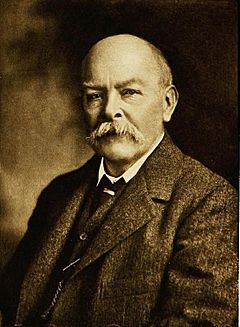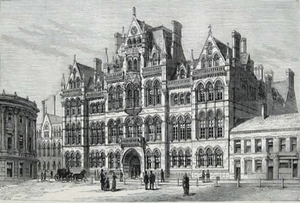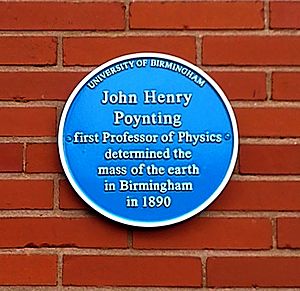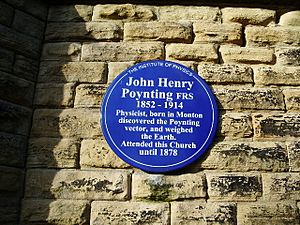John Henry Poynting facts for kids
Quick facts for kids
John Poynting
|
|
|---|---|

John Henry Poynting
|
|
| Born | 9 September 1852 Monton, Lancashire, England
|
| Died | 30 March 1914 (aged 61) Birmingham, England
|
| Nationality | English |
| Alma mater |
|
| Known for | Poynting vector Poynting effect Poynting's theorem Poynting–Robertson effect |
| Awards |
|
| Scientific career | |
| Fields | Physicist |
| Institutions | Mason Science College, University of Birmingham |
| Academic advisors | James Clerk Maxwell |
| Notable students | Francis William Aston; Alfred J. Lotka |
| Influences | Edward Routh |
| Signature | |
John Henry Poynting FRS (born September 9, 1852 – died March 30, 1914) was an important English physicist. He became the very first professor of physics at Mason Science College in 1880. Later, this college became the University of Birmingham, where he continued teaching until he passed away.
Contents
Discovering John Poynting's Life
John Poynting was the youngest son of Thomas Elford Poynting, who was a minister. He was born in Eccles, Lancashire, where his father worked. As a boy, he went to a school run by his father.
He later studied at Owens College (now the University of Manchester). After that, he went to Cambridge University. In the late 1870s, he worked at the Cavendish Laboratory with James Clerk Maxwell, a famous scientist. In 1880, he started his job as the first physics professor at the University of Birmingham.
Poynting's Amazing Discoveries
John Poynting made several big contributions to science.
Understanding Energy Flow
He is famous for the Poynting vector. This is a special tool that helps scientists understand how electromagnetic energy moves and in what direction. It's used in the Poynting theorem, which explains how energy is conserved for electric and magnetic fields. He first shared this idea in 1884.
Measuring Earth's Weight
In 1893, he found a new way to measure Newton's gravitational constant. This constant helps us understand the strength of gravity. It was a very clever experiment for its time.
The Poynting–Robertson Effect
In 1903, he was the first to realize something amazing about the Sun. He figured out that the Sun's light can actually pull tiny dust particles closer to it. This effect was later named the Poynting–Robertson effect. It helps explain how dust moves in space around stars.
Twisting and Stretching Materials
Poynting also discovered something about how materials behave when you twist them. He found that twisting can also cause a material to stretch or shrink. This is now known as the Poynting effect in twisting.
Writing Physics Textbooks
He worked with J. J. Thomson, who won a Nobel Prize, to write a physics textbook for college students. This book was very popular and used for about 50 years! Poynting wrote most of it himself.
Honors and Later Life
In 1901, he received an honorary degree from Birmingham University. John Poynting lived in Edgbaston, Birmingham, for many years. He passed away in 1914 at the age of 61. He was survived by his wife, a son, and two daughters.
Poynting's Lasting Legacy
John Poynting's ideas continue to influence science today.
Inspiring Future Scientists
One of his most famous students was Alfred J. Lotka. Poynting inspired Lotka to use physics ideas to study biology. Lotka even dedicated his important book on how populations grow to Poynting.
Names in Space
There are craters named after him on both Mars and the Moon. This shows how important his work was in understanding space.
Buildings and Societies
The main physics building at the University of Birmingham is named after him. There's also a popular student group there called 'The Poynting Physical Society' (PPS), which he helped start.
The Greenhouse Effect
He is also credited with using the phrase "greenhouse effect" in 1909. He used it to explain how certain gases in the atmosphere, like carbon dioxide, can trap heat and make Earth and Mars warmer.
Images for kids
See also
 In Spanish: John Henry Poynting para niños
In Spanish: John Henry Poynting para niños





